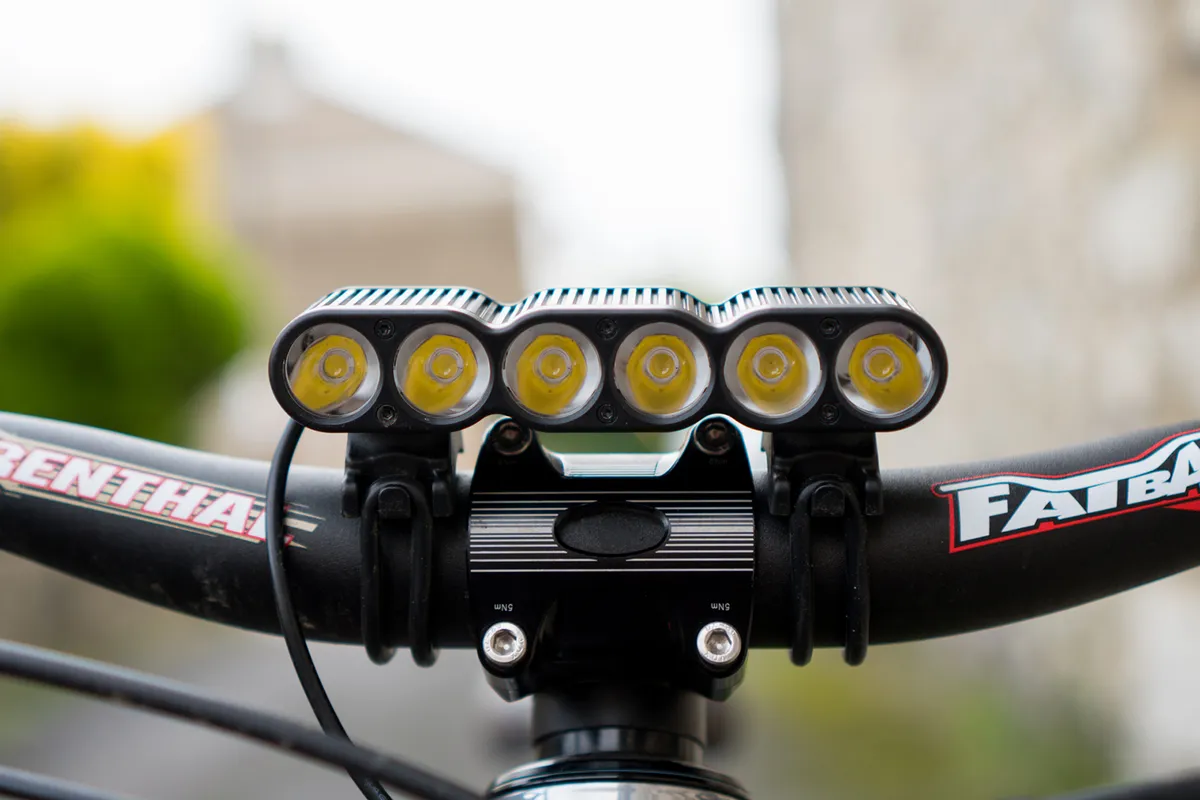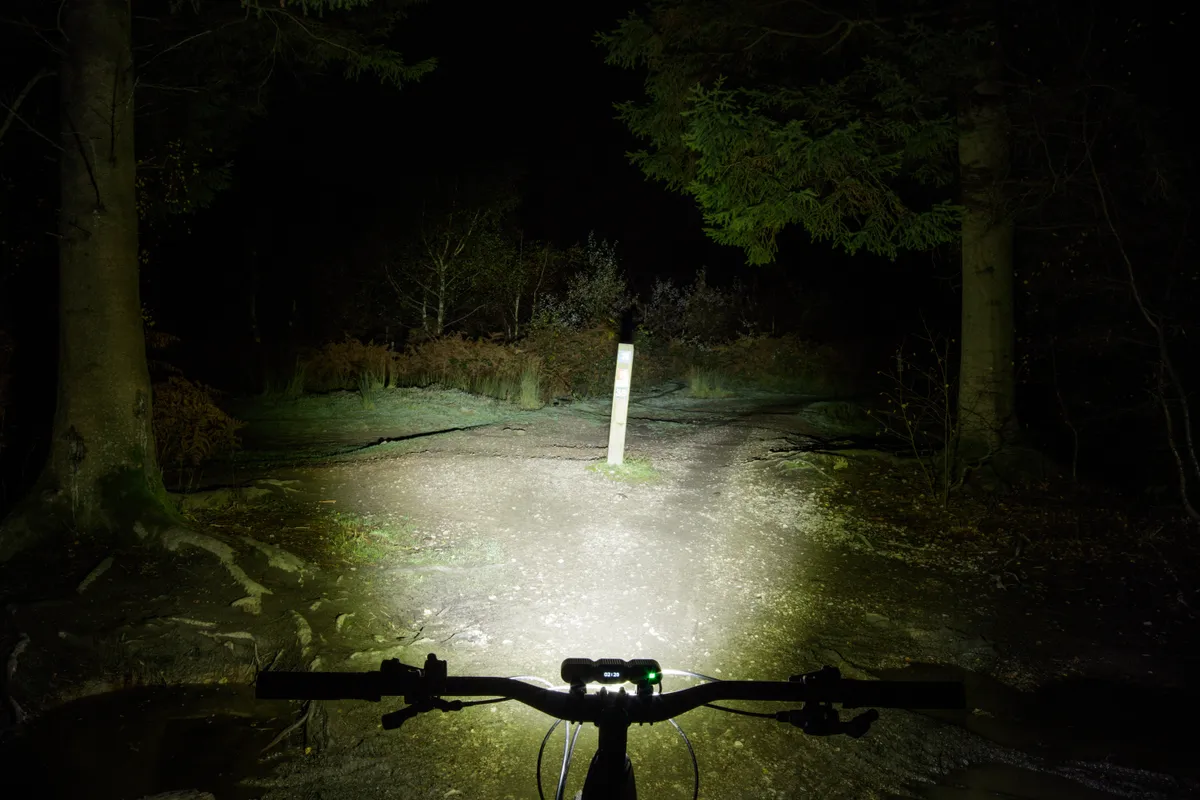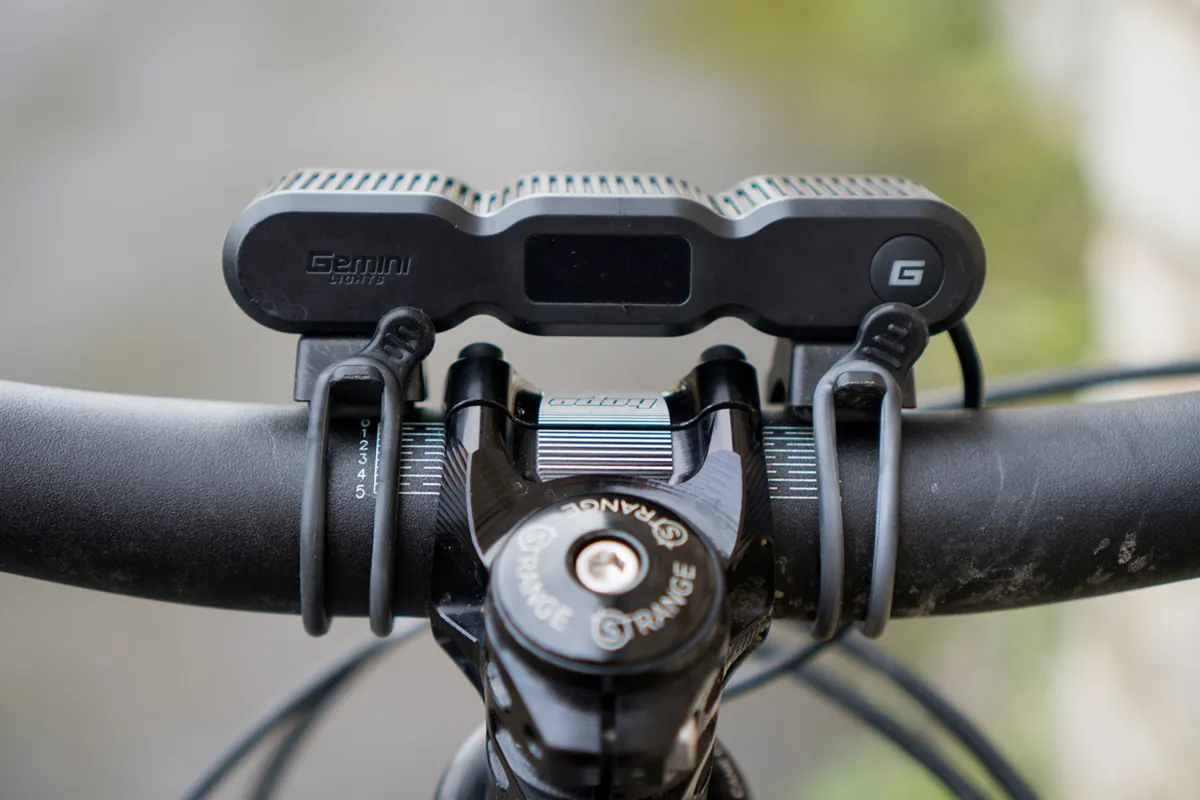Gemini's Titan 4000 front light has been a top-performer for us in the past, but has this new version that's been updated for 2019/2020 still got what it takes to keep its star credentials?
Gemini Titan 4000 OLED details and specification
With a massive claimed 4,000-lumen output from six in-line LEDs, a wireless remote and an updated light unit, which now features an OLED rear-mounted display providing mode and battery information, it looks like Gemini has addressed some of the concerns previously highlighted by our testers.
The horizontally aligned LEDs are designed to sit in the centre of a bike's bars, bridging the stem. At either end of the light unit are clips with rubber O-rings that wrap around the bars, which are compatible with both 31.8mm and 35mm sizes.

The light isn’t compatible with helmet mounts, though, and Gemini states it should only be used on your bars.
Not only does it have more functionality over the outgoing model, the battery pack is lighter and more powerful, upping power from 29 to 30 watts. It’s also shed its fabric cover and is now clad in a polycarbon shell, but still attaches using a Velcro strap.

Charged via a USB-C port that sits behind a rubber cover, the port can also be used to charge external devices should you wish. It comes with a wireless remote control with two buttons — one to turn it off and one to cycle through its modes — that attaches to the bars using another rubber O-ring. Different sized O-rings are supplied with the light that will work with both the head unit and remote.

Gemini claims the light has a 25-degree beam angle, which is a full 10 degrees wider than the outgoing model.
Gemini Titan 4000 OLED performance
The Titan certainly lives up to its name, offering titanic power and range that certainly does turn night into day. The light’s power output is also predictable; it’s obvious where the beam is shining and there are no surprise shadows, dark spots or weird patterns created by the LEDs' lens.
The power seems to be evenly shared between spot and flood lighting and the luminance on offer is exceptional, providing excellent trail detail, which makes riding fast a doddle. Couple this with the beam’s yellowy-white hue and it illuminates the trail in a natural-looking light and has insane power, so there’s very little that remains in the dark.

The beam’s forward flood reaches very far indeed, giving great visibility on the trail ahead, making riding fast a complete walk in the park. The focussed spot light’s intense power brings up plenty of detail but the edge of the beam’s side-to-side spread is quite abrupt and not as wide as I was hoping for.
With the amount of power and LEDs on offer, and Gemini claiming a 10-degree increase in beam width over the out-going model, I was hoping for a wider spread of light closer to the light’s source – where it matters most.

Further ahead the light’s sideways spread is impressive and more than wide enough, but up close it just doesn’t quite go wide enough.
Unfortunately, when you’re turning or riding technical terrain this narrow close-to-rider beam width is something that really dampens the experience and, maybe, by increasing the beam’s spread further in to the distance Gemini has reduced it closer to the light.
This problem isn’t devastatingly bad, however, and you’ll only notice it when the trails get extreme or twisty — although these are conditions you’d naturally be encouraged to ride with this level of power on offer.

The light’s mounting system is fantastically easy to use and tool-less to boot. This makes swift changes from one bike to another an absolute doddle.
The supplied rubber O-rings gripped the bars with enough force to keep the light completely stable even over particularly rough or fast terrain.
Likewise, the battery and remote are easy to mount to the bike’s frame and handlebar. The remote’s O-ring is tight enough and the buttons easy enough to push to make it possible to use in anger.

In the stock settings the light is quite simple to use but will require a quick read of the instructions to fully understand what the buttons on the remote do, but once you’ve got the controls dialled it’s a breeze.
It is possible to programme the light’s modes, too, but the standard modes of 30, 50 and 100 per cent brightness were more than adequate.
The rear OLED screen clearly displays battery and mode information along with a countdown timer so you can see exactly how much run time you’ve got left. Having accurate information like this makes riding in the dark much easier and you don’t need to worry about whether it’s going to conk out unannounced.
As the battery runs down the power button changes colour, eventually flashing red when it’s on its last legs. This is a great addition over the outgoing model.
Although a little less than the claimed 2 hours 40 minutes at 4,000 lumens, the light ran for 2 hours 25 minute at maximum, which is still phenomenal.
The battery’s plastic body looks good and feels robust. The Velcro straps supplied with the light were gutsy enough to hold it securely in place and its thin shape means that it’ll fit in the nooks and crannies of frames.
The cord attaching the head unit to the battery pack is just over 40cm long and is connected using a push-fit system. Although it’s not long enough to get to the far flung reaches of your frame, I’d be surprised if you couldn’t mount it successfully somewhere on your bike within the confines of the cord’s length.
Gemini Titan 4000 OLED bottom line
The Gemini’s Titan still stands true to its name, offering blisteringly bright performance, but this latest versions isn’t without a few issues. In increasing the beam’s spread further away from the bike, Gemini has reduced how much light is cast side-to-side where it matters most.
You’d have thought with the number of LEDs on tap and the power available that some of that light could have been spread around more evenly.
This problem isn’t a deal breaker though — the large £350 / $350 / AU$450 price might do that —and the light’s a seriously capable bit of kit thanks to its battery life, power, run-time readout and ease of use. It just seems like the competition has aimed for the benchmark previously set by Gemini and hit it, which means the Titan isn’t the only stand-out light on offer anymore.
How we tested
Testing lights objectively is a tough task. While it’s entirely possible to measure the number of lumens a light emits, there are a lot more variables that dictate how much of that light illuminates the trail. The colour of the light, its beam pattern and lens type have as much effect as the outright power.
With that in mind, we haven’t measured the number of lumens each light emits for this test. Instead, we’ve assessed how the light performs by describing the beam pattern, its colour and overall performance, while also measuring run time on the most powerful setting.
Product
| Brand | Gemini |
| Price | A$450.00, €370.00, £350.00, $350.00 |
| Weight | 491g |
Features
| Light type | front |
| Remote switch | yes |
| Integrated battery | no |
| Features | Clamp weight: 7g Head unit weight: 131g Battery weight: 353g Run time: 2 hours 25 minutes (max power) |
| Output (lumens) | 4000 |








